Master Builder Crafts a Dream Workshop
Imagine the workshop a master craftsman would build for himself. “I knew if I built it using our standard methods, it would be $200,000, easy,” says John Zerrer, builder and owner of a high-end design-build firm in historic Stockton, New Jersey. Zerrer runs his business operations from a barn on his 8-acre property, but he wanted a dedicated space in which to store his crew’s tools and equipment, as well as a workshop where they could build trim and other custom millwork for their projects.
His company had recently restored three 18th-century barns on a property down the road from his home, and it got him thinking about how he wanted the shed to look. He wanted to construct a shed large enough to handle everything he needed, one that would blend with his home’s wooded setting and wouldn’t cost a fortune. He decided to pursue the pole barn method, an economical construction technique often used for farm buildings, garages and accessory buildings.
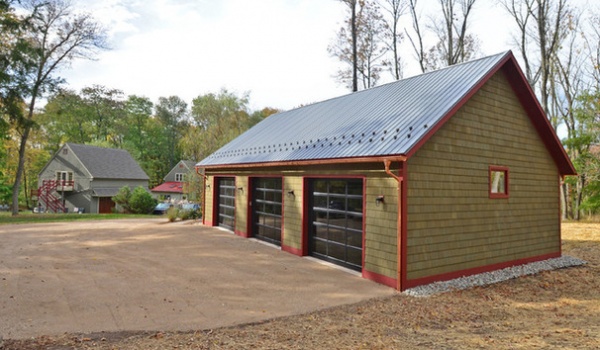
“The basic pole barn typically looks cheap,” Zerrer says. Pole barns are built without a foundation and instead have poles set in the ground and a truss roof. They are usually finished with inexpensive siding and windows and overhead doors. “That’s what makes them affordable,” he says.
Using a pole barn frame and roof kit from Kistler Buildings, Zerrer’s craftsmen finished and trimmed it using their building techniques. They covered the exterior with cedar sidewall shingles and installed double-pane Marvin windows. Stick-frame walls between the poles allowed them to build flat walls and run wires. The trim is made by Boral and is a resilient composite material that can stand up to the weather and the area’s wildlife. Boral trim boards along the ground prevent moisture and boring insects from entering.
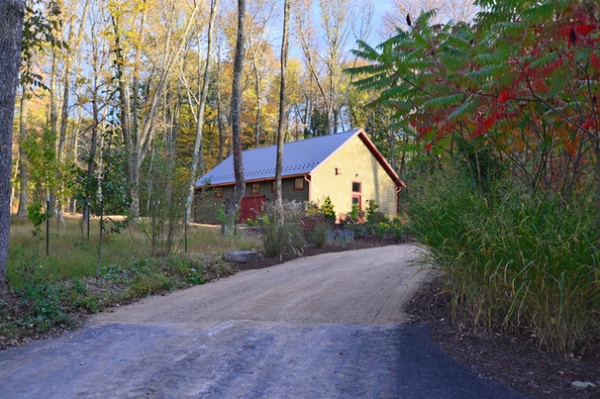
The 1,300-square-foot structure blends well with property’s lush surroundings. Zerrer stained the cedar a semitransparent green and accented it with a rich red trim. The barn doors aren’t functional, but they reference the region’s vernacular architecture and welcome visitors coming up the property’s long gravel driveway.
“We’re all looking for ways to economize without sacrificing quality,” Zerrer says. He has calculated that building the workshop with the pole barn method not only cut construction costs by 20 percent, but also cut 20 percent off construction time, since there was no foundation to prepare.
Trim paint: Terra Cotta Tile, Benjamin Moore
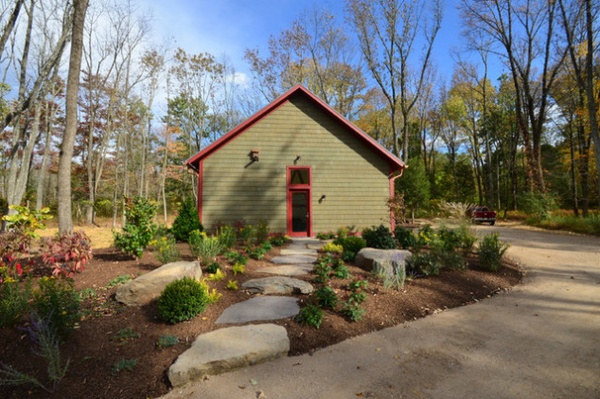
A stone pathway leads from the main house and driveway out to the workshop, surrounded by native planted gardens. And though Zerrer says the landscaping is pretty low maintenance, there are times during the summer when it really needs to be watered.
Stockton receives 46 inches of rain on average per year, and instead of directing the roof’s copper downspouts to a drain, Zerrer ran them underground to a 500-gallon concrete tank. From there a heavy-duty pump moves the water into two water hydrants on the property for irrigation. The tank sits in an oversize gravel pit; the water can spill into the gravel pit and back down into the landscape if it ever overflows the tank.
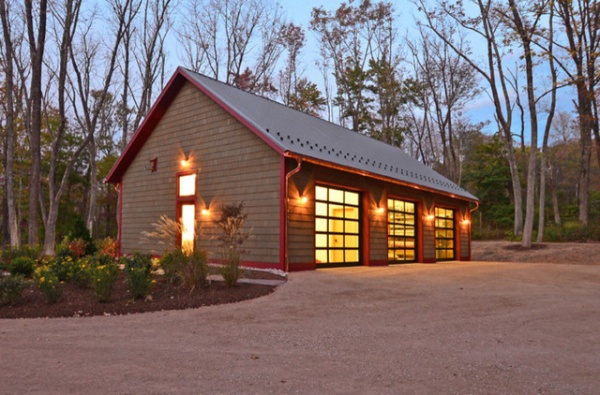
Zerrer was excited about visiting his workshop in the evenings. “I love seeing lights in the woods at night,” he says. But that meant having to walk from the house out to the shed in the dark and turn the lights on and then off again later in the night. When the garage doors were installed, the installer included LiftMaster remote switches, allowing Zerrer to open and close the doors using an app on his smartphone. He also installed a remote switch on the building’s interior and exterior lights so that Zerrer could control those with his phone too.
Garage doors: Garaga
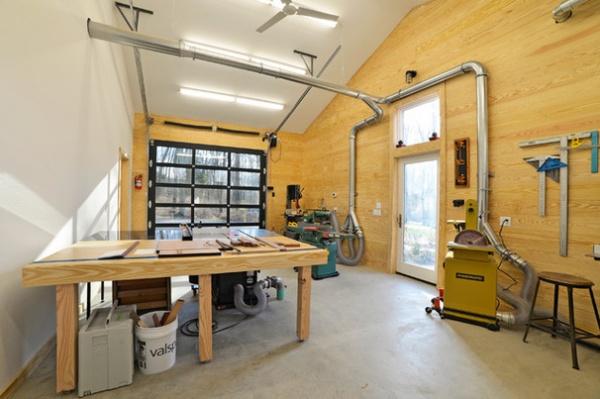
Inside, the workshop is divided into three 16-foot wide areas, with the workshop occupying the end closest to the house. Zerrer finished this area differently from the other two areas, since it would house the tools he used for shaping beautiful wood pieces and would be where he spent the most time.
On the barn project that inspired this shed’s shape, the team had finished the walls with yellow pine tongue and groove paneling, which Zerrer really liked. So they covered two of the workshop’s walls with that same material.
For added comfort he installed a wall-hung propane heater. Outside he covered the exhaust vent to look like a birdhouse (seen above the door at the end of the gable). The rest of the shed is insulated with a 2-inch layer of spray foam. The garage doors face south for some solar gain.
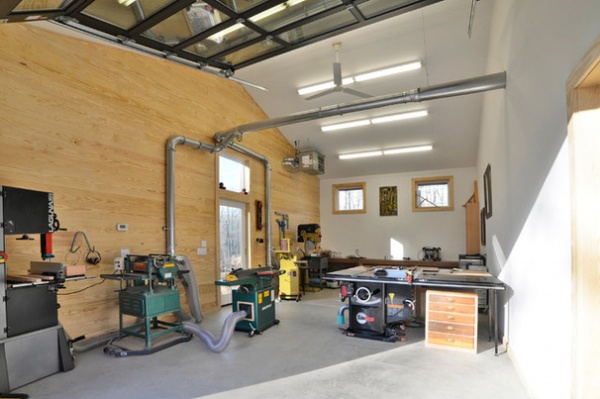
Zerrer’s tool assemblage comes from years of collecting and includes, among other items, an industrial-grade SawStop table saw. The tool has a sensor that will stop the blade from spinning within five milliseconds if it touches skin. The green tools are a planer and a joiner. The gold tools are by Powermatic and include a combination disk and belt sander, drill press and bandsaw. Everything is hooked up to a pretty extensive vacuum system.
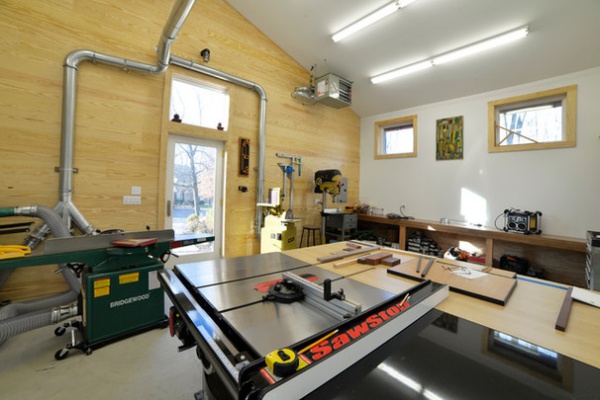
Other craftspeople complete some of the firm’s more artistic pieces, and millwork pieces often get completed onsite, but sometimes Zerrer’s workers use the studio to finish custom trim or cabinets. Now that he has the space, he’s also excited to revisit more creative pursuits in the shop. “I am trying to get back into more artistic and sculptural woodworking,” he says; that includes wall panels featuring exotic wood appliqués.
Zerrer apprenticed under Phillip Lloyd Powell, a contemporary of George Nakashima, and has carried what he learned from him into the work his business produces. “I never made my mark as a woodworker, choosing instead to be a builder,” says Zerrer, but he didn’t leave that passion behind: “I always made sure to have many woodworking details on my projects.” The Morris Berd painting on the wall was a gift from Powell.
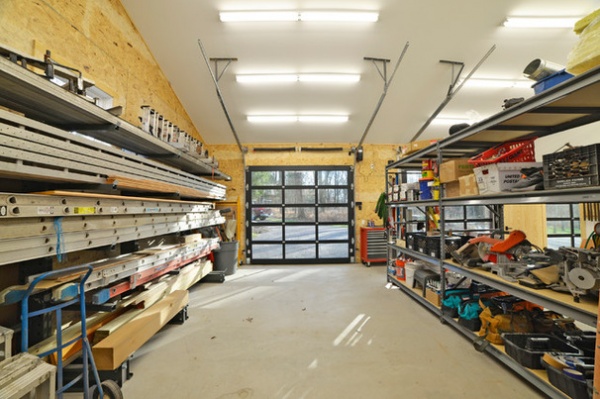
Two 16-foot-wide storage bays sit next to the workshop and house tools, ladders and the occasional extra-large woodworking project. When laying out this area, Zerrer knew he wanted heavy-duty storage. He hung ladder racks from Uline along one wall and placed shelving from the same line between the two storage bays.
Sometimes Zerrer needs to drive a truck into the bays or work on an extra-large project, and so he stores all the equipment and supplies along the perimeter and on the walls to keep the floor space open. “The most important part of the space is the emptiness,” he says. “Now if I want to grab something, I can see it. Before, I had this Quonset hut and everything was buried. Sometimes I thought I would just give up.”
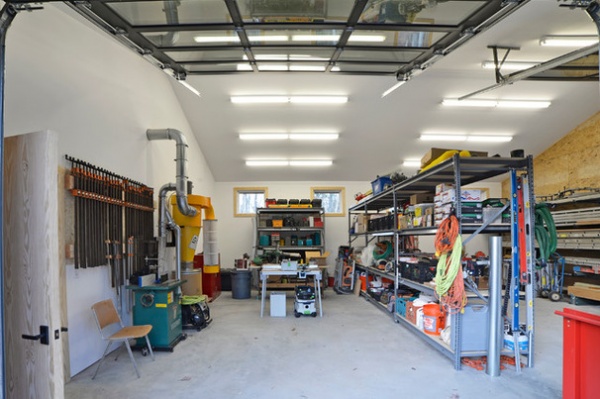
Tall ceilings also contribute to the shed’s open feeling and provide Zerrer and his crew with plenty of space to work with the 10-foot-, 12-foot- or 16-foot-long boards they often handle. The garage doors are on tracks that follow the ceiling’s pitch so that none of the room’s 16-foot ceilings are cut off.
“I’m really in love with this building,” Zerrer says.
More:
14 Home Studios That Nurture Creativity and Art
How to Add a Backyard Shed for Storage or Living












